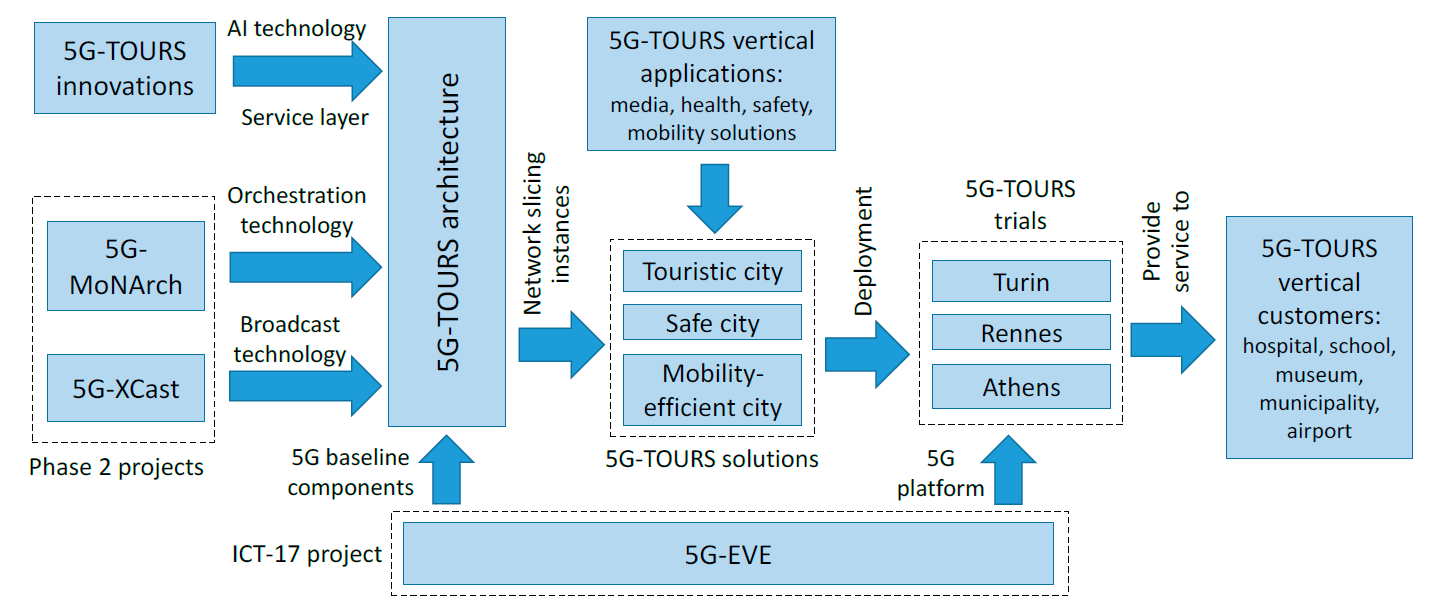The main steps considered in the approach followed by 5G-TOURS are (i) the design and deployment of an architecture composed of the pre-commercial components brought by the 5G-EVE platform along with the innovations coming from Phase 2 projects and 5G-TOURS itself, (ii) the implementation of the 5G-TOURS solutions that combine the use of the appropriate network slicing instances of the architecture and the vertical solutions relying on 5G communication that needed for the use cases, and (iii) the deployment of trials to evaluate the 5G-TOURS vertical solutions on top of the 5G-EVE nodes.
The ultimate goal of 5G-TOURS is to bring 5G deployments to a real use. To this end, a set of use cases have been defined to provide services to the vertical customers involved in the consortium, which include a school, a museum, a hospital, a municipality and an airport. The different use cases have been grouped around three themes, the touristic city, the safe city and the mobility-efficient city, which will be deployed in three of the nodes provided by the 5GEVE platform. Specifically, the touristic city use cases will be deployed in the Turin node, the safe city use cases will be deployed in the Rennes node and the mobility-efficient use cases will be deployed in the Athens node. In these nodes, 5G-TOURS will rely on the mobile network infrastructure provided by 5G-EVE, deploying the required mobile network innovations and vertical solutions on top of this infrastructure, as detailed below.
While the 5G-TOURS architecture will be based on the pre-commercial mobile network deployment provided by the 5G-EVE platform, in order to provide the functionality required for trialing the use cases envisaged in 5G-TOURS, some additional functionalities are needed beyond those provided by 5G-EVE: (i) orchestration solutions that adapt the deployment of network slices to meet the requirements of the addressed verticals use cases; (ii) broadcasting techniques to satisfy the needs of the media-related use cases; (iii) artificial intelligence mechanisms that allow to dynamically manage and configure the different functions in large-scale deployments such as the ones considered in 5G-TOURS, and (iv) a service layer that allows to provide verticals with an interface that meets the specific needs of the vertical customers addressed by 5G-TOURS.
The resulting 5G-TOURS architecture will rely on the baseline network components specified by 5G-EVE and will use the interfaces provided by these components in order to interoperate with the 5G-TOURS innovations, which will be implemented on top of the pre-commercial platform. For those innovations that have already been implemented in Phase 2 projects (orchestration and broadcast), 5G-TOURS will bring the existing solutions from the corresponding projects (namely 5G-MoNArch and 5G-XCast, respectively), adapting them as needed. The remaining innovations will be designed and implemented by 5G-TOURS. The design of the various innovations addressed by 5G-TOURS will be compliant with ongoing standardization efforts and will be fed into the standards in order to push their eventual adoption in commercial products.
Leveraging on the 5G-TOURS mobile network architecture, the project will address the implementation of the use cases comprised within its vision of the touristic city, the safe city and the mobility-efficient city. This will require the instantiation of network slices that provide the desired network services, along with the implementation of vertical solutions that use these network services to provide the functionalities required by the use cases. Such vertical solutions comprise among others, media applications, e-health devices for monitoring and intervention, sensors and applications for smart mobility, etc. Note that the consortium includes a number of vertical solution providers that will take care of developing these applications and integrating them with the underlying network end-devices.


